| 2008 Country Profile: Russia PDF version PDF version

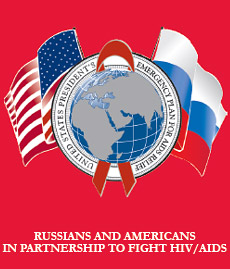 |
|
2008 Country Profile: Russia
National HIV prevalence rate among adults (ages 15 to 49): 1.1 percent1
Adults and children (ages 0-49) living with HIV at the end of 2005: 940,0001
AIDS deaths (adults and children) in 2005: 22,000-56,0001
AIDS orphans at the end of 2005: not available1
Under PEPFAR, Russia received nearly $10.3 million in Fiscal Year (FY) 2004, approximately $14 million in FY 2005, and approximately $13.9 million in FY 2006 to support an integrated HIV/AIDS prevention, treatment and care program. PEPFAR is providing $14.6 million in FY 2007. | |
Recognizing the global HIV/AIDS pandemic as one of the greatest health challenges of our time, President George W. Bush announced the President’s Emergency Plan for AIDS Relief (Emergency Plan/PEPFAR) in 2003 — the largest international health initiative in history by one nation to address a single disease. The United States is changing the paradigm for development, rejecting the flawed “donor-recipient” mentality and replacing it with an ethic of true partnership. These partnerships are having a global impact and transforming the face of our world today.
Partnership to Fight HIV/AIDS
In Russia, the Emergency Plan supports the fight against HIV/AIDS by partnering with a broad range of governmental and non-governmental organizations, including those representing people living with HIV/AIDS. These partnerships are promoting the “Three Ones” principles:
- To establish and strengthen one national HIV/AIDS coordinating authority;
- To develop and implement one national HIV/AIDS plan; and
- To develop and implement one HIV/AIDS monitoring and evaluation system.
The “Three Ones” serve as a framework for U.S. Government support of integrated, comprehensive and evidence-based HIV/AIDS programs in Russia.
| Emergency Plan Results in Russia |
| # of individuals receiving antiretroviral treatment in fiscal year 2007 |
|
0 |
| # of pregnant women receiving prevention of mother-to-child HIV transmission (PMTCT) services in fiscal year 2007 |
|
36 |
| # of pregnant women receiving antiretroviral prophylaxis for PMTCT in fiscal year 2007 |
|
300 |
| # of counseling and testing encounters (in settings other than PMTCT) in fiscal year 2007 |
|
8,800 |
| Note: All USG bilateral HIV/AIDS programs are developed and implemented within the context of multi-sectoral national HIV/AIDS strategies, under the host country’s national authority. Programming is designed to reflect the comparative advantage of the USG within the national strategy, and it also leverages other resources, including both other international partner and private-sector resources. The numbers reported reflect USG programs that provide direct support at the point of service delivery. Individuals receiving services as a result of the USG’s contribution to systems strengthening beyond those counted as receiving direct USG support are not included in this total. Numbers may be adjusted as attribution criteria and reporting systems are refined. Numbers above 100 are rounded to nearest 100. |
|
HIV/AIDS in Russia
Over the past decade, Russia has experienced one of the fastest growing HIV/AIDS epidemics in the world. Russia identified its first case of HIV in 1987, and until 1995 the prevalence rate remained low. In 1996, the infection rate exploded with 1,515 new cases. After reaching its highest level to date in 2001, the annual number of newly diagnosed cases of HIV/AIDS in Russia has remained relatively steady. At the end of 2005, there were approximately 350,000 registered cases of HIV/AIDS in Russia. However, these figures do not adequately represent the situation, as many HIV/AIDS cases are not officially reported. The Joint United Nations Programme on HIV/AIDS (UNAIDS) estimates that approximately 1.1 percent of Russia’s adult population ages 15 to 49 were living with HIV/AIDS in 2005.1
HIV/AIDS in Russia is transmitted primarily through injecting drug use. Increasingly, HIV is transmitted by male injecting drug users to their sexual partners. As a result, rates of HIV infection among women are also growing. In 2005, approximately 210,000 women were living with HIV/AIDS, almost one-third higher than was reported two years earlier.1
1 UNAIDS, Report on the Global AIDS Epidemic, 2006. |
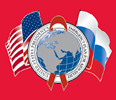 |
Emergency Plan Achievements in Russia to Date |
|
Challenges to Emergency Plan Implementation
The growing HIV/AIDS epidemic in Russia challenges already under-resourced health care and social service systems. Administrative reforms in 2004 created additional challenges in efforts to coordinate among Government of Russia institutions at federal and regional levels. In particular, coordination among state agencies responsible for addressing medical, legal and social aspects of HIV/AIDS is minimal. Stigma directed at people living with HIV/AIDS, injecting drug users, men who have sex with men, people in prostitution and prisoners makes it difficult to target these at-risk groups with HIV/AIDS services. Long-standing social issues, such as alcoholism and drug abuse, contribute to risky sexual behavior and subsequently to the spread of HIV/AIDS. |
| Resource Needs Assessment Increases Regional Commitments to Combating HIV/AIDS
With Emergency Plan support, the Healthy Russia 2020 Project trained Russian governmental and non-governmental organization representatives to use the Resource Needs Model to evaluate the cost-effectiveness of and resource distribution among HIV/AIDS interventions. HIV/AIDS stakeholders use the model in regional and municipal HIV/AIDS budget planning. For example, in Irkutsk, Orenburg and Ivanovo, regional planners evaluated the use of financial resources for HIV/AIDS programs. The results of the analysis led these planners to increase spending for prevention efforts. In Orenburg, the Government also decided to increase its overall funding levels for HIV/AIDS programs. The Resource Needs Model also served as the foundation for a four-year, $7.5 million budget for special HIV/AIDS programs and events. This new way of analyzing HIV/AIDS programs represents a sea of change in the attitudes of regional decision-makers toward the fight against HIV/AIDS.
|
|
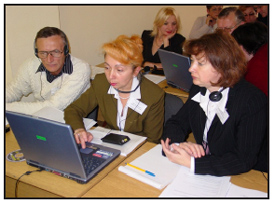
Russian Regional Medical Personnel attend a training
on the Resource Needs Model. |
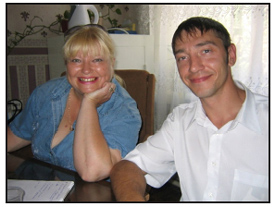
Olga Fyodorova and Vladimir Dementyev are
pioneering the new system of health care service
delivery for people living with HIV/AIDS in Engels,
Russia. |
|
Case Managers Improve Care and Support for HIV-Positive Clients
The Emergency Plan is supporting efforts to improve the quality and scope of health care and related services available to people living with HIV/AIDS (PLWHA) through a twinning partnership between Russia and the United States. PEPFAR twinning programs strengthen human and organizational capacity by creating relationships between similar organizations. These relationships facilitate skills transfer and can rapidly expand the pool of trained providers, managers and health staff delivering quality HIV/AIDS services. In Russia, the PEPFAR-supported twinning partnership pairs new Russian HIV/AIDS case managers with experienced case managers from Minnesota and New York. In the Saratov Oblast city of Engels, Olga Fyodorova and Vladimir Dementyev, two HIV/AIDS case managers, are pioneering a new system of health care service delivery for PLWHA. Thanks to training through the twinning partnership, Olga and Vladimir now provide comprehensive care and support services to their HIV-positive clients. They are able to link clients with antiretroviral and tuberculosis treatment, counseling for discordant couples, and employment and legal services. They also provide assistance with disability pension applications. The new case management system has significantly improved services for PLWHA in Engels and throughout Russia.
|
| Business Leaders Fight Stigma and Discrimination
HIV/AIDS poses a growing threat to regional economies, international investment, labor markets and workers’ rights. In response, the Emergency Plan supports efforts of Russian and multi-national companies to address HIV/AIDS in the workplace. The Emergency Plan provides assistance for workplace prevention and non-discrimination programs, including the innovative HEALTH@WORK training, used by Alfa-Bank, AvtoVAZ, BP, Unilever and others. Together, these firms employ over one million Russians in the transportation, oil and gas, manufacturing and heavy industry sectors. The program has organized major business summits on HIV/AIDS, which were attended by over 200 business leaders and government officials. In addition, the program is working towards the goal of creating a national association of “Businesses Against AIDS.”
|
|
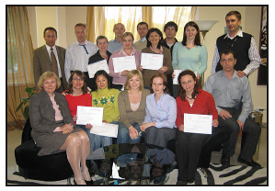
Instructors and peer educators participate in a
HEALTH@WORK training at Sakhalin Energy
Investment Company LTD on May 30, 2006. |
| |  |  |




 PDF version
PDF version